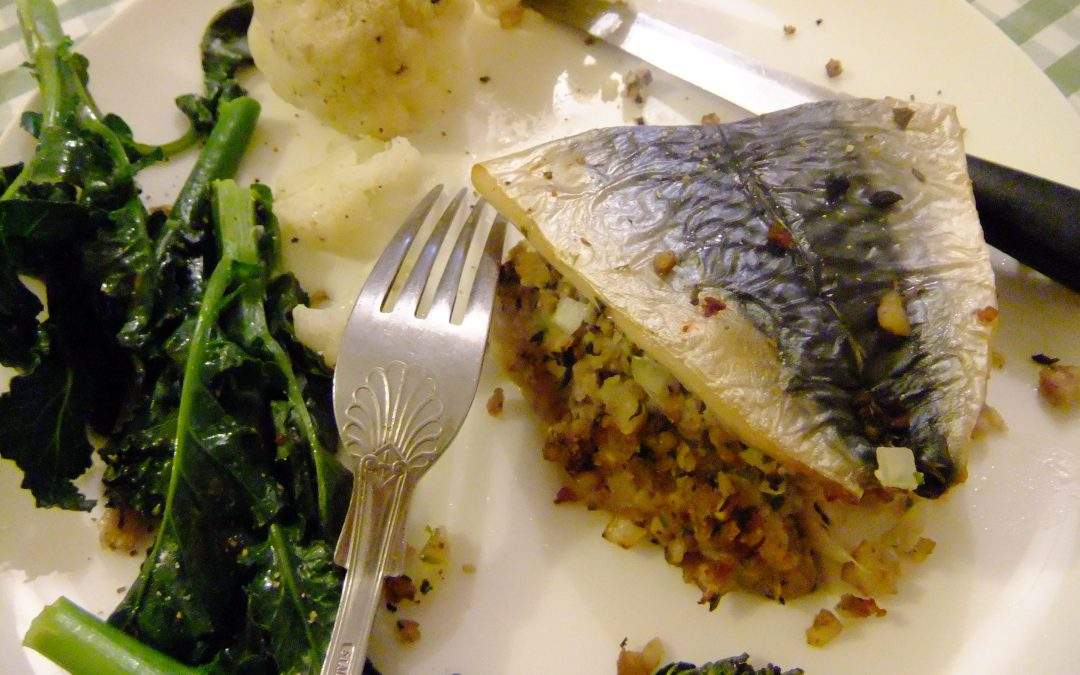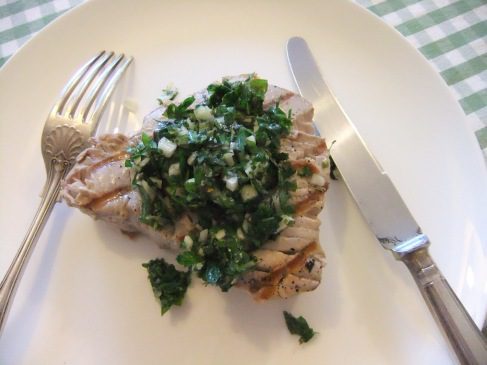
Nov 27, 2013 | Anna's Best Recipes, Main courses
I took a notion with some leftover stuffing last week and made this and it was lovely, moist and rich. It brought me right back to sister Carmel’s home economics class in my convent school many years ago. Only she used breadcrumb stuffing instead of gluten-free chestnut stuffing. If you want, you can make the stuffing (posted last week) using gluten-free brown breadcrumbs instead of the chestnut. It works just as well provided you add enough oil or butter to moisten the crumbs so they will stick together when pressed with your hand.
For 2
1 1/2 -2 cups of my chestnut stuffing (you don’t have to be exact here)
2 fresh mackerel fillets
I roasting tin, pyrex dish or baking sheet
A little oil to grease
- Preheat the oven to 200C and grease the tin (just the merest hint of oil to prevent the fish sticking).
- Cut the mackerel fillets in half across the fish (not lengthways).
- Lay one half of each fillet skin side down in the tin, top with half the stuffing. Lay the second half on top of each, skin side up this time.
- Bake for 15-20 minutes, depending on the size of your fillets. When done, the point of a skewer or sharp knife will slip easily through the flesh once you have pierced the skin. You want the fish still moist and juicy and not dried out.
Serve with:
Steamed green vegetables and carrots topped with a knob of virgin coconut oil, a drizzle of lemon juice or a glug of extra virgin olive oil.
Why this recipe is good for you:
Mackerel is a great source of vitality-boosting omega 3 oils and baking it rather than frying preserves the omega 3 benefits. Herbs and spices are a powerhouse of anti-inflammatory substances that promote health. Hundreds of thousands of high quality research papers now show that herbs have powerful effects for good on your health – from delaying aging, to helping heal an inflamed digestive system, to even helping your liver cope with too much rich food (and drink). Chestnuts are low GI (low in natural sugars), making them a healthier option than breadcrumbs.

Jul 16, 2013 | Anna's Best Recipes, Main courses
This is inspired by a very simple treatment of a steak that I once ate in sunny Amalfi. It was so fresh and zingy I loved it and tried to recreate the taste when I got home. We also use the gorgeous herb-and-garlic topping for a venison steak or a piece of lean sirloin, simply done on a barely-oiled pan. The herbs you use in addition to the parsley depend on what’s convenient for you to buy or pick from your garden.
For 2:
2 tuna steaks, about 120g each (about the size of your palm)
1 small handful of parsley (flat-leaf is nice if you can get it)
A sprig (about 8-10cm long) of rosemary, 3-4 sprigs of thyme, or a handful of oregano sprigs (or all 3 if you are lucky enough to grow your own herbs and have a plentiful supply)
2-3 cloves garlic
Extra virgin olive oil
Freshly ground black pepper
A pinch of Himalayan or Atlantic Sea Salt
To serve: a large mixed salad, with dressing, or 350g steamed French or runner beans
- First of all, wash and dry your herbs and destalk them. you will want, in total about 3 tablespoons of chopped herbs. Then chop as finely as you can manage. The finer the herbs, the less chewy the topping will be. Peel and chop the garlic cloves as finely as you can manage. Add the chopped herbs and garlic to a bowl, season with a few good grinds of black pepper, a pinch of salt, and enough extra virgin olive oil to wet the whole thing so it sticks together a bit. Mix and set aside.
- Prepare your salad or put your beans on to steam before cooking the tuna steaks.
- Heat a heavy-bottomed frying pan or griddle pan. Oil it lightly using some macadamia or olive oil, just enough to get a non-stick film on the pan but not enough to see an oil slick.
- On medium heat, cook the steaks for around 4-5 minutes on each side (it depends on the thickness of the steak). It’s ok to leave fresh tuna a little pink in the middle and it’s moister and more delicious that way.
- Once the steaks are done, slide onto warm plates and pile the garlic-herb mix on top of each one.
- Serve with the salad or steamed French or runner beans.
Dietary note:
Fresh (not tinned) tuna is a great source of omega 3 oils. Garlic and herbs contain potent antioxidants which also enhance many functions in the body, from dampening down inflammation and allergies to boosting liver function. Regularly eating fresh herbs, garlic and oily fish has positive effects on mood, skin health, and digestive wellness. The raw extra virgin olive oil used here is a source of vitamin E which is also anti-inflammatory and anti-ageing. People adding olive oil, raw nuts, and raw seeds to their diet lose weight, according to scientific research.

Jul 4, 2013 | Anna's Best Recipes, Cook-in sauces, Dressings, rubs, spreads, sauces & more, Main courses
We ate this last weekend after arriving back from a few days away, desperate to get away from bland food. This is a beautiful, aromatic cook-in sauce for vegetables, white fish or lean meat. People always ask for the recipe when I serve it up. It is equally nice with fish, chickpeas, or chicken. You could also use it to reheat leftover cooked lamb or beef or as a cook-in sauce for peeled prawns. It stores well in the freezer so you could make a large batch, freeze in individual portions, and thaw as needed. this amount of sauce is enough for 4 people, or 2 with leftover sauce to put in the freezer.
3 medium onions
3cm piece fresh ginger
2 large fat cloves garlic (optional)
1 tbsp virgin coconut oil (or olive oil if you can’t get coconut)
1 rounded tsp ground coriander
1 level tsp ground cardamom
1/2 level tsp ground cloves
1 level tsp ground cinnamon
1 rounded tsp turmeric
1/3–½ level tsp chilli powder (optional – avoid if you don’t like heat!)
1 x 65ml tin coconut milk (or 60g creamed coconut + 300ml/1¼ cups boiling water)
300ml/1¼ cups passata (sieved tomatoes) or 1 tin tomatoes, liquidized
1 tbsp chopped fresh coriander
Pepper
A food processor/liquidiser
1. Finely dice the onion, grate the ginger and crush the garlic. Place in a saucepan with the coconut oil or olive oil and 1 tbsp water and sweat them with the lid on over a low heat until the onion begins to soften/go translucent.
2. Add the spices and sweat for a few more minutes.
3. If using creamed coconut, dissolve it in the boiling water and place it in a food processor. If using coconut milk place in the processor with around 200ml water. Add two-thirds of the onion mixture and process until smooth.
4. Put the processed mixture back into the pan and add the passata and fresh coriander. Simmer for 5 mins, then season to taste with pepper.
5. Freeze in containers ready for future use or use for cooking any of the ideas below.
6. Serve with brown rice.
Cook-in ideas (just heat sauce in a heavy-bottomed saucepan to prevent burning, add your ingredients to be cooked, then cover with a lid):
- Fish & veg: Allow 100-120g white fish (skinned and cut into 2.5cm cubes) and 2 cups of broccoli florets or thawed/fresh peas per person. If using broccoli, cook it in the sauce until almost done, then add the fish, which only takes a few minutes. If using peas, you can add the fish and peas at the same time.
- Chicken & veg: Allow 100g chicken fillet (cut in 1cm slices or 2cm cubes) plus 2 cups sliced runner beans or broccoli florets per person. Heat the sauce, add everything else, cover with a lid and cook till done, stirring occasionally (around 10 minutes).
- Chickpeas & veg: Allow 1 cup of cooked drained chickpeas plus 2 cups green veg (eg. broccoli florets or green beans) per person. Throw the whole lot into the simmering sauce, cover with a lid and cook for around 8 minutes until the vegetables are softened but not overcooked.
Why this is good for you:
Research shows that all spices have anti-aging, antioxidant, health-boosting properties. Onions and garlic are great sources of soluble fibre, which feeds the helpful gut bacteria needed for proper digestion, mental clarity, and clear skin. Soluble fibre also binds to natural and man-made toxins (such as chemicals, used-up hormones, and medications) in your digestive system, ensuring that they exit the body quickly and as safely as possible.



